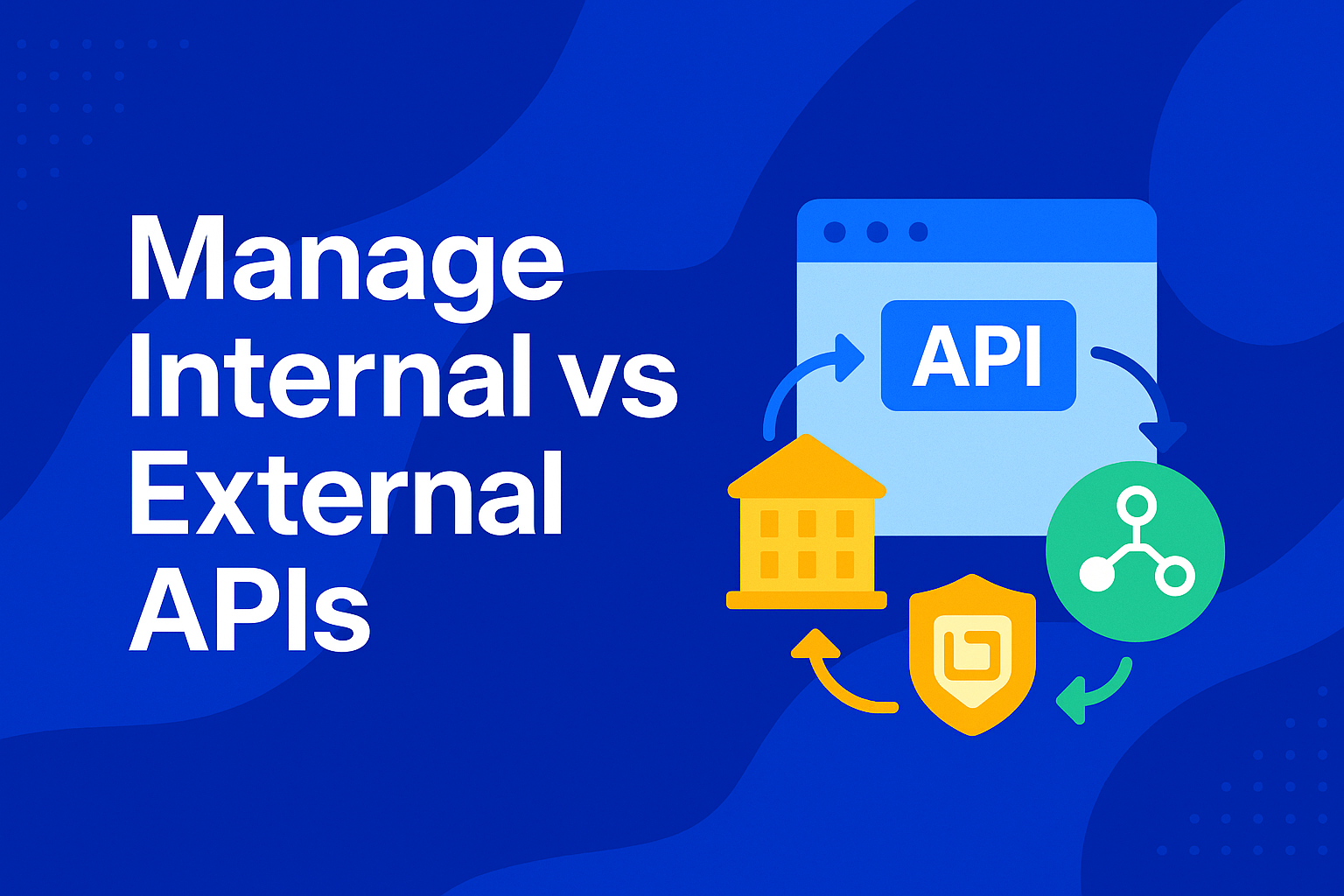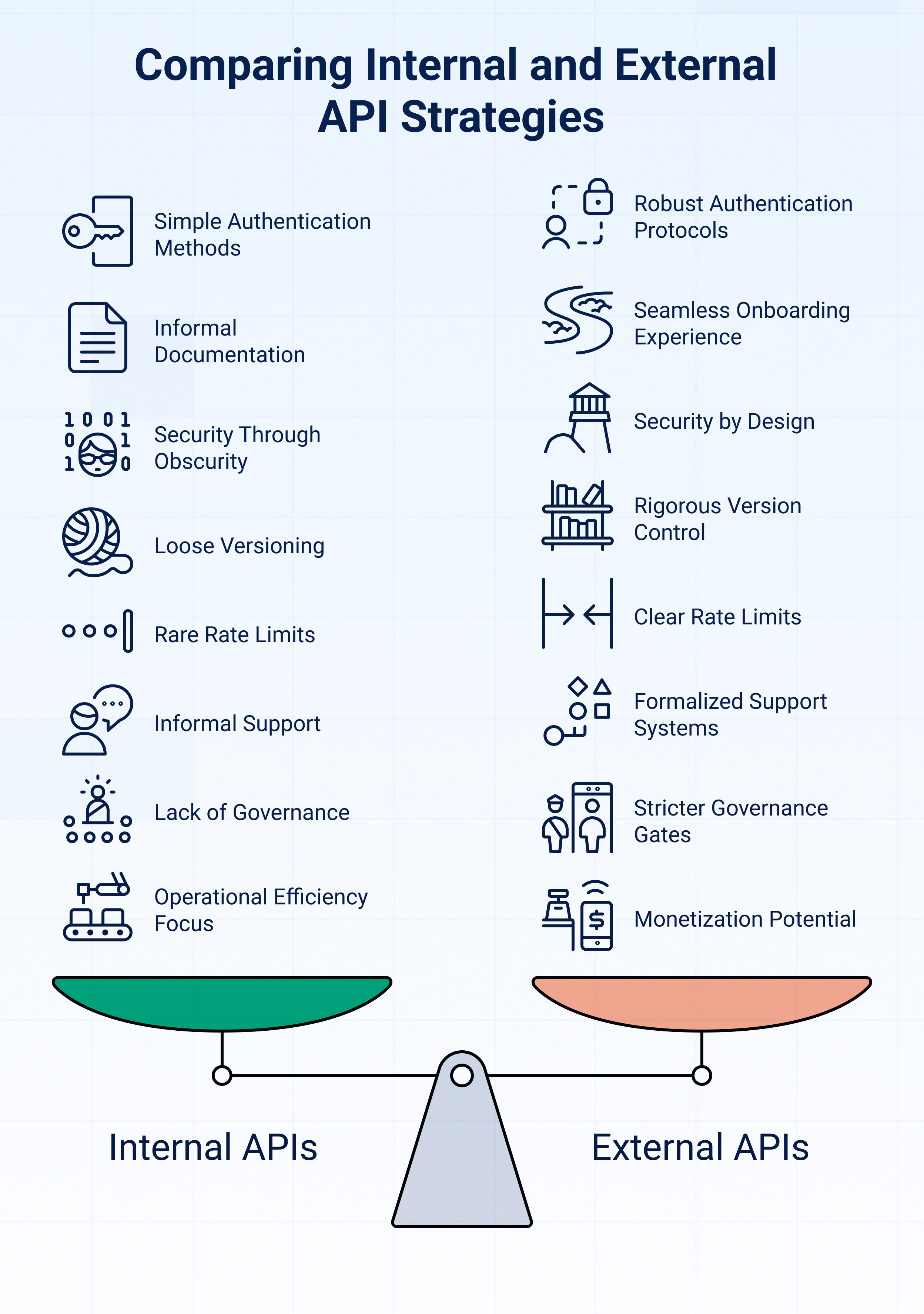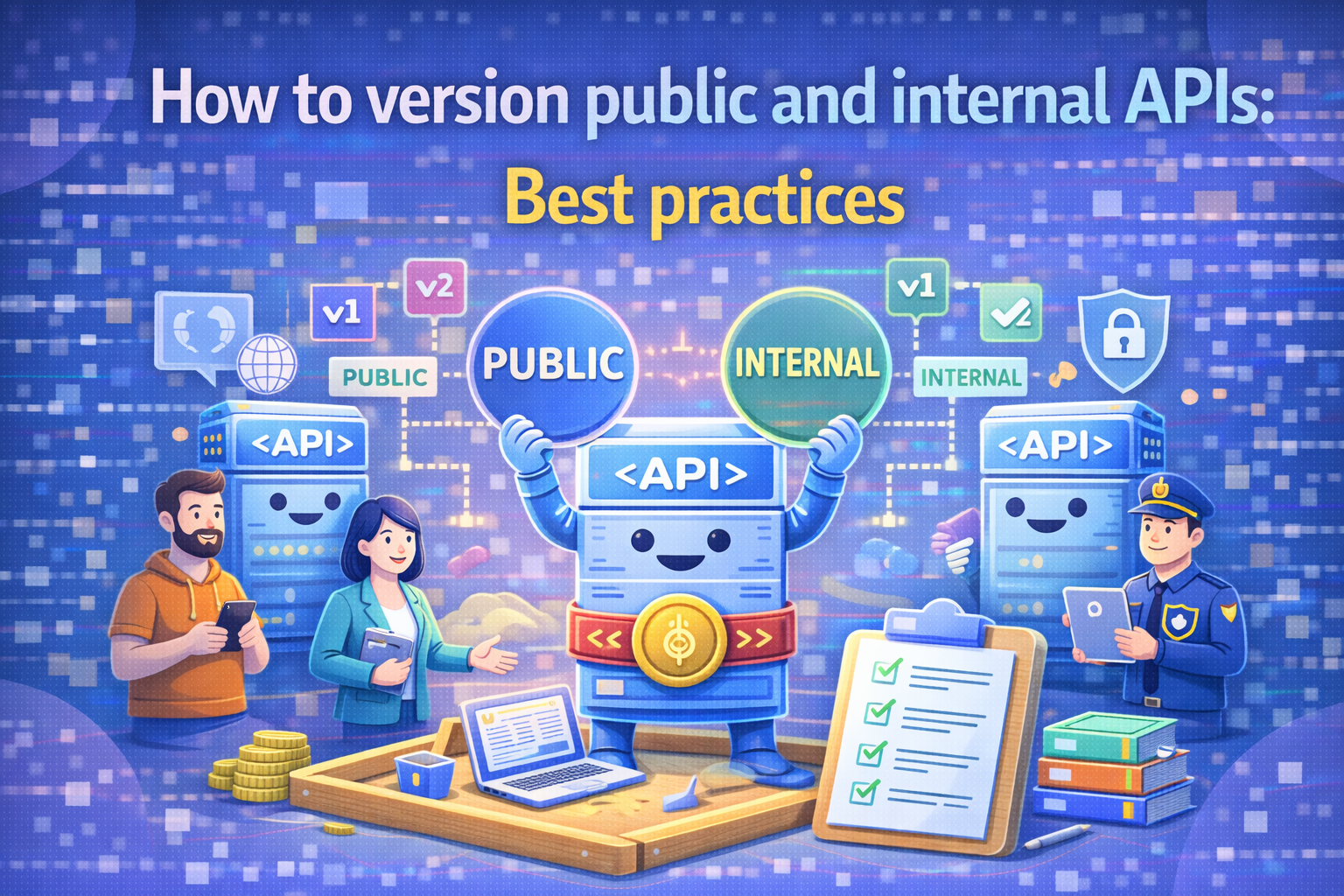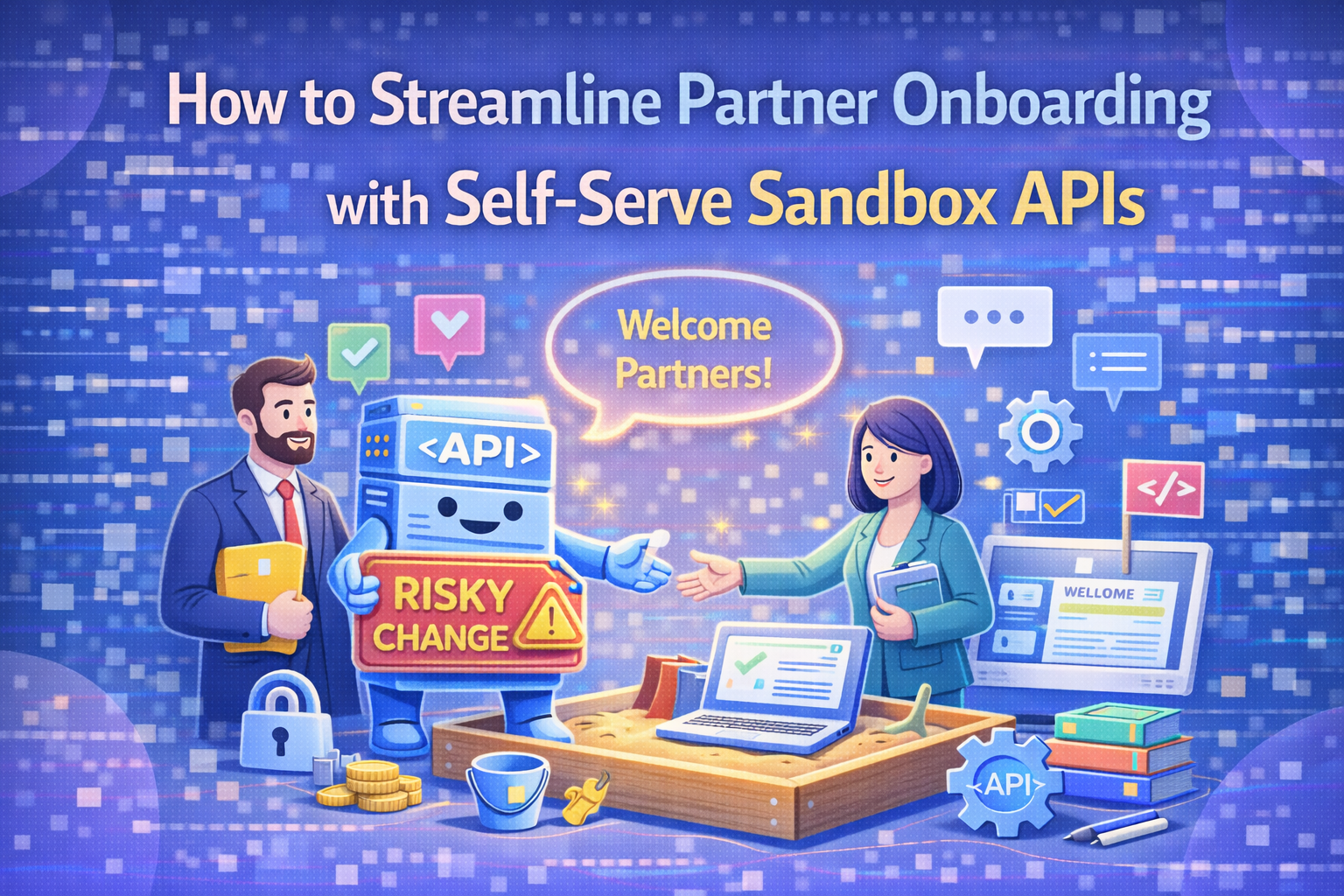Blog
How to Manage Internal vs External APIs with DigitalAPI Developer Portal
Updated on:

APIs power nearly every digital experience today, from internal tools used by employees to customer-facing products and partner integrations. But not all APIs are created equal. One of the most critical distinctions in an enterprise API strategy is between internal (private) APIs and external (partner or public) APIs. While both expose business capabilities, they differ significantly in purpose, visibility, governance, and developer experience.
Treating internal APIs as afterthoughts while polishing only external APIs is a common misstep. In reality, API sprawl, inconsistent access controls, and fragmented developer experiences arise when organisations fail to manage both types holistically. As more companies adopt platform thinking and shift towards API-as-a-product models, having a clear strategy for internal vs external APIs isn’t just good hygiene it’s a competitive advantage.
This blog explores their key differences, trade-offs, and how a modern API developer portal offered by DigitalAPI helps you manage both at scale.
What is an Internal API?
An internal API, also known as a private API, is designed exclusively for use within an organisation. It allows different internal teams, services, or applications to communicate securely, share data, and automate workflows without exposing the API to partners or the public. These APIs are essential for scaling modern, microservices based architectures.
Unlike external APIs that prioritise documentation and external onboarding, internal APIs are optimised for speed, control, and internal developer productivity. They power everything from HR dashboards and internal analytics to backend infrastructure for mobile apps and websites. For example, a finance team might consume an internal billing API to automate month-end reports without needing to build from scratch.
However, internal APIs are often under-documented, poorly governed, and hard to discover especially in large enterprises with multiple dev teams and gateways. This lack of visibility leads to duplication, inconsistent standards, and slower time-to-market. A key part of a modern enterprise API strategy is treating internal APIs as products, with proper governance, access control, and discoverability just like their external counterparts.
What is an External API?
An external API is designed to be accessed by users or systems outside the organisation. Also called public APIs or partner APIs, they expose selected business capabilities to customers, vendors, fintechs, or third-party developers enabling collaboration, ecosystem growth, and new revenue streams through API monetisation or partner integration.
External APIs are a core pillar of digital platform strategies. For instance, a bank might expose a customer identity verification API to fintech partners, or an e-commerce brand may offer a public product catalog API to affiliates. These APIs require robust authentication, rate limiting, documentation, and developer onboarding flows to ensure secure, scalable use beyond internal boundaries.
Unlike internal APIs, external ones must deliver a polished API developer experience often via a self-serve portal. They’re also subject to higher security scrutiny, compliance requirements, and SLAs. Exposing an API externally turns it into a business product, meaning governance, monitoring, and support are just as critical as the code behind it.
Core differences between Internal vs External APIs

While internal and external APIs both expose digital capabilities, their design, governance, and usage contexts are fundamentally different. Here are the most important differences that impact security, scalability, and the overall API developer experience.
1. Access and authentication
- Internal APIs are typically restricted to internal networks, cloud environments, or VPNs. They may use simple authentication methods like service tokens, mTLS, or shared secrets. Since users and consumers are known entities like internal teams, microservices, or CI/CD pipelines the focus is often on speed and efficiency over frictionless access control.
- External APIs are exposed to third-party developers, partners, or customers, and must assume that any incoming request could be malicious. They require more robust authentication protocols like OAuth 2.0, API keys, or signed JWTs. These APIs also often include developer registration workflows, token management dashboards, and dynamic permissioning. This extra layer is critical for trust, especially in partner API ecosystems or public developer programs.
2. Documentation and onboarding
- Internal APIs often rely on informal or outdated documentation, if any exists at all. Developers may have to rely on Confluence pages, Notion docs, or Slack threads to understand how the API works. This leads to steep learning curves, bottlenecks when team members leave, and reduced API reuse across departments.
- External APIs are expected to provide a seamless, self-serve onboarding experience. That means clean, interactive API documentation, usage examples, SDKs, and developer guides often hosted on a public or private developer portal. For external developers, first impressions matter. A confusing or poorly documented API can be the reason they churn before even integrating.
3. Security and compliance
- Internal APIs may benefit from some “security through obscurity” due to network isolation, but that doesn’t make them safe by default. Without proper access control, observability, and security policies, internal APIs can become a risk vector especially in large enterprises with sprawling infrastructure and complex IAM systems.
- External APIs are exposed to the internet and must be built with security by design. This includes input sanitisation, IP whitelisting, DDoS protection, encryption, and often compliance with strict regulations like GDPR, HIPAA, PCI-DSS, or Open Banking standards. For regulated industries like banking, healthcare, and insurance, external API compliance isn’t optional, it’s core to operations.
4. Versioning and lifecycle management
- Internal APIs evolve fast. Teams working in the same org can coordinate breaking changes via sprint planning or internal meetings. As a result, versioning may be loose or informal. However, this flexibility can cause issues at scale when multiple teams or services depend on undocumented contracts.
- External APIs, on the other hand, require rigorous version control and deprecation strategies. Any change can impact thousands of users or external partners. Best practices include semantic versioning, long-term support for older versions, and transparent communication of breaking changes. Maintaining backwards compatibility is crucial when APIs are part of a productised external platform strategy.
5. Rate limiting and usage policies
- Internal APIs rarely implement strict rate limits, assuming internal consumers won’t abuse the system. That said, observability is still vital. Without tracking usage, some APIs may become performance bottlenecks or cost drivers, especially in cloud-native environments with auto-scaling workloads.
- External APIs must include clear rate limits, quotas, and often tiered access plans. These not only protect backend systems from abuse or overload but also support API monetisation strategies. Enterprises may expose premium APIs with higher limits for paying customers, or offer sandbox environments with test limits for new partners.
6. Developer support and feedback loops
- Internal APIs benefit from proximity. If something breaks, you can ping someone on Slack or raise a ticket in the same system. But this also means support is informal, inconsistent, and unscalable across larger teams or multiple geographies.
- External APIs require formalised support systems. That includes developer forums, ticketing workflows, changelogs, service status pages, and dedicated support teams. The feedback loop must be treated like product feedback. Successful external API teams treat documentation, support, and roadmap transparency as part of the API developer experience.
7. Governance and discoverability
- Internal APIs often lack a unified catalog or registry, leading to API sprawl. Teams may unknowingly build duplicate services, re-implement core logic, or use outdated APIs. Without governance, internal APIs become untraceable, unauditable, and unmaintainable.
- External APIs typically go through stricter governance gates, often managed by an API product or platform team. APIs are published with clear ownership, versioning, and lifecycle metadata, and are made discoverable via developer portals or marketplaces. Discovery, analytics, and feedback mechanisms are baked into the external API platform architecture.
8. Monetisation potential and business exposure
- Internal APIs are rarely monetised directly. Their value lies in operational efficiency, internal reuse, and faster delivery across teams. For example, an internal payments API might serve finance, HR, and procurement systems, cutting redundancy and improving standardisation. Their ROI is measured in terms of productivity gains, reduced duplication, and API reuse across business units.
- External APIs, by contrast, are business enablers. Enterprises increasingly treat them as digital products, unlocking revenue via API monetisation (usage-based billing, tiered access, partner licensing, etc.). A fintech might charge for access to credit scoring APIs; a logistics company may monetise tracking or fulfilment APIs. APIs exposed to partners or developers can generate entirely new revenue streams and form the backbone of platform business models.
Internal APIs and External APIs: Where do they matter?
Understanding the difference between internal and external APIs is just the beginning. What truly sets leading organisations apart is how they use each type of API strategically, not just to connect systems, but to drive business outcomes. Let’s explore where internal and external APIs matter most across an enterprise, and how they create value in different contexts.
Where Internal APIs Matter Most
- Backend system integration: Internal APIs connect microservices, databases, and internal apps in a modular, reusable way powering everything from employee dashboards to automated reporting.
- Cross-team reuse: When product, ops, and data teams can discover and consume shared APIs (e.g. a customer identity API), it reduces duplication and enables platform thinking.
- Rapid internal innovation: Developers build faster when APIs are discoverable and dependable. Internal APIs serve as the building blocks for new apps and features without reinventing the wheel.
Internal APIs are about speed, control, and reuse helping teams move faster with shared capabilities.
Where External APIs Matter Most
- Partner and B2B integrations: Whether it’s fintechs consuming banking APIs, or logistics firms integrating with e-commerce platforms, partner APIs are the backbone of digital ecosystems.
- Product extension and monetisation: Many companies expose APIs to customers and developers as part of their offering, e.g. map APIs, payment APIs, AI inference APIs, and charge based on usage or tier.
- Open innovation: By offering public APIs, businesses invite external developers to build new use cases, integrations, or even startups around their data and services.
External APIs are about reach, monetisation, and ecosystem growth, transforming APIs into business products.
Benefits and trade‑offs of Internal vs External APIs
Internal and external APIs play very different roles in an enterprise. Internal APIs are geared toward operational efficiency, developer speed, and reuse. External APIs, meanwhile, are outward-facing interfaces that enable monetisation, partnerships, and ecosystem integration. Here’s a more complete comparison of the benefits and trade-offs of each:
Internal API Benefits
- Faster development cycles: No need to wait for external approvals or production hardening, teams can move fast and break things.
- Cross-team reusability: A single internal API (e.g. auth, payments, user profile) can serve multiple applications across departments or business units.
- Tighter access control: Internal traffic is easier to manage via service meshes, internal IAM tools, or VPN-based segmentation.
- Less formal documentation needed (initially): Teams can iterate and evolve APIs with limited bureaucracy in early development phases.
- Cheaper to maintain (at small scale): With fewer compliance requirements, internal APIs are simpler to launch and monitor, especially within a single environment.
- Supports rapid experimentation: Internal APIs allow dev teams to build prototypes and MVPs without external pressure or exposure.
- No risk of brand exposure: If something breaks, it impacts internal teams not partners or paying customers.
Internal API Trade-offs
- Low discoverability across teams: Without a unified developer portal, APIs get lost in GitHub repos, wikis, or tribal knowledge.
- Hard to govern at scale: Multiple teams building APIs leads to duplication, inconsistent security, and lack of lifecycle management.
- Difficult to measure adoption: Without usage analytics or central visibility, it’s unclear which APIs are critical and which are redundant.
- Limited incentives to treat APIs as products: Teams may focus only on delivery, not on usability or experience for other devs.
- Technical debt accumulates quickly: Lack of ownership, versioning, or standards leads to legacy APIs that no one wants to touch later.
- No external feedback loops: Internal APIs don’t benefit from market input, reducing opportunities to improve or commercialise them later.
External API Benefits
- Revenue generation via monetisation: APIs can be offered as a service with tiered pricing, unlocking new business models.
- Scalable partner integrations: External APIs let partners and customers plug directly into your platform, at low marginal cost.
- Improved developer experience standards: External APIs push teams to adopt OpenAPI specs, proper error handling, and onboarding flows.
- Compliance and observability become mature: Public exposure forces better implementation of governance, monitoring, and version control.
- Drive adoption of your core product: Companies like Stripe, Twilio, and Shopify use APIs to increase stickiness and ecosystem depth.
- Boosts brand and platform visibility: Well-documented APIs become discoverable via API marketplaces or dev communities, increasing exposure.
- API-as-a-Product discipline: Teams treat APIs like real products, with roadmaps, feedback channels, SLAs, and KPIs.
External API Trade-offs
- Higher engineering overhead: Security, rate limiting, analytics, and support infrastructure require dedicated effort.
- Slower to release: External APIs go through more checks: legal, privacy, compliance, security reviews, and partner agreements.
- Greater support burden: Your team becomes responsible for external developers’ success, often with tiered or 24/7 support models.
- Strict change management: Breaking changes require sunset timelines, migration plans, and multi-version maintenance.
- Requires API product thinking: Teams must shift from “shipping an endpoint” to “shipping an experience,” which not all orgs are ready for.
- Exposure to misuse or abuse: Without proper governance, public APIs are prone to scraping, fraud, or excessive usage by bad actors.
How to manage Internal and External APIs at scale?
Managing APIs becomes exponentially harder as organisations grow. What starts as a handful of services can quickly evolve into hundreds of internal and external APIs, spread across teams, environments, and gateways. Scaling API operations requires visibility, governance, and productisation across both private and public APIs. Here’s how leading teams manage both effectively:
1. Centralise API discovery with a unified catalog
One of the biggest challenges at scale is API sprawl. Without a central catalog, internal teams can’t find existing APIs, and external developers can’t easily explore capabilities. A unified API directory, segmented by access level ensures discoverability, reuse, and faster onboarding across internal, partner, and public consumers.
2. Enforce consistent governance policies
As your API landscape grows, inconsistency becomes a liability. Implement shared governance policies across both internal and external APIs, including naming conventions, OpenAPI specifications, lifecycle rules, and security standards. A governance layer helps enforce structure without slowing down development.
3. Segment access using role-based controls
Not all APIs should be visible to everyone. Internal APIs may be sensitive or pre-release, while external APIs may require usage agreements. Use RBAC (Role-Based Access Control) and environment tagging to ensure the right APIs are visible only to the right audiences, dev teams, partners, or customers.
4. Monitor usage and performance across APIs
You can’t improve what you can’t see. At scale, it’s critical to track which APIs are being called, by whom, and how often. Usage analytics help identify high-value APIs, detect anomalies, enforce rate limits, and plan capacity. For external APIs, this also supports API monetisation and SLAs.
5. Standardise documentation and developer experience
Each API, internal or external, should follow the same design and documentation principles. Use tools to auto-generate docs from source (e.g. OpenAPI), provide examples, and include testing options like Try-it-Out or Postman collections. This improves the developer experience and reduces support overhead.
6. Automate lifecycle and version management
Without automation, managing hundreds of APIs leads to versioning chaos. Define clear lifecycle stages (dev, staging, prod, deprecated) and automate versioning, retirement, and notifications. This reduces operational risk and ensures internal and external consumers aren’t caught off-guard by changes.
7. Treat APIs as products, regardless of audience
The most scalable teams apply API product thinking to both internal and external APIs. That means assigning owners, capturing feedback, publishing roadmaps, and measuring adoption. When every API is treated as a product with a clear purpose and user, you unlock scale, innovation, and maintainability.
Best Solutions for Managing Internal vs External API Traffic
Balancing internal and external API traffic is critical for maintaining performance, security, and scalability. Internal APIs often power mission-critical business processes, while external APIs expose services to partners and developers. The right solution ensures smooth operations without sacrificing reliability or security.
- Traffic Segmentation – Apply tailored rules for internal and external consumers to enforce governance.
- Unified Monitoring – Track performance, errors, and usage trends across all APIs in one place.
- Scalable Controls – Use quotas, throttling, and automated scaling to handle growing demand securely.
With DigitalAPI, organizations can unify internal, external, and even third-party API traffic in a single platform, ensuring secure, efficient, and consistent API delivery at scale.
How DigitalAPI Developer Portal help you manage both internal and external APIs with RBAC?
DigitalAPI’s Developer Portal provides a single, unified interface to catalog, discover, and manage APIs across multiple gateways and clouds. It organizes all your APIs and events into an internal searchable hub, enabling internal teams to easily discover and adopt APIs while also eliminating duplication. The developer portal also comes with RBAC (role-based access) to ensure users are able to access API endpoints and resources only relevant to their assigned roles.
Apart from an internal portal, DigitalAPI also offers an external portal to monetize APIs. Businesses can choose which APIs they want to make public from the internal catalogue and launch their own branded marketplace with built in sandbox and self-serve experience for developers.
Additionally, the API developer portal integrates analytics and usage metrics across gateways, helping platform teams monitor adoption, enforce rate limits, and support API monetisation where applicable. It promotes consistent lifecycle management, versioning, and feedback loops, treating all APIs as products, regardless of audience. So, what are you waiting for? Get started today!
FAQs:
1. What is the difference between internal vs external APIs?
Internal APIs are built for use within an organization, helping teams integrate systems and streamline workflows. External APIs are shared with partners or developers outside the company, enabling ecosystem growth and monetisation. The main difference lies in accessibility, security needs, and governance models—internal APIs prioritize efficiency, while external APIs require stricter controls.
2. What are the best solutions for managing internal vs external API traffic?
The best way to manage API traffic is by segmenting internal and external consumers, applying role-based access, and enforcing quotas or throttling where needed. Unified monitoring and analytics ensure visibility, while automated scaling maintains reliability. Platforms like DigitalAPI simplify this by centralizing control and securing all API flows.
3. How do you manage third-party APIs in a developer portal?
Third-party APIs should be cataloged alongside internal and external ones for better visibility, governance, and security. A developer portal helps standardize documentation, monitor usage, and apply consistent policies. With tools like DigitalAPI, businesses can track integrations, manage credentials, and prevent shadow IT risks by bringing all APIs under one controlled environment.
4. What are best practices for onboarding external developers in an API platform?
Effective onboarding requires clear documentation, interactive “try-it-now” features, sandbox environments, and sample code. Providing FAQs, Postman collections, and community support speeds up adoption. Tracking usage and collecting feedback helps refine the experience. Platforms like DigitalAPI automate onboarding flows, reducing time-to-first-success and ensuring external developers integrate smoothly with your APIs.
5. How does a developer portal help in exposing APIs?
A developer portal simplifies secure API exposure by acting as a central hub where APIs are published, documented, and governed. It provides branding, access controls, and interactive testing while managing authentication and monitoring. DigitalAPI enables enterprises to expose APIs confidently, ensuring the right users access the right services while maintaining security and scalability.
You’ve spent years battling your API problem. Give us 60 minutes to show you the solution.
.svg)

%20(1).png)




